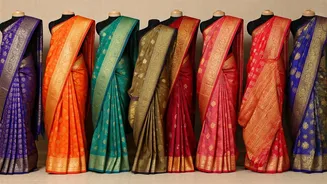India: A Fashion Hub
India is gaining prominence in the global fashion industry. Several factors contribute to this rise. India's large population, coupled with a growing middle
class and increased disposable income, creates a significant consumer base. Moreover, the nation's cultural diversity and rich heritage provide a unique platform for fashion trends. As the Indian economy strengthens, it offers a stable environment for foreign brands to flourish. This growth is attracting considerable investment and innovation within the Indian fashion landscape. International fashion houses are strategically positioning themselves to tap into this promising market. The confluence of these elements positions India as a pivotal player in the evolving global fashion scenario, offering a rich tapestry of opportunities.
Brands Eyeing India
Numerous global fashion brands are currently focusing their attention on the Indian market. These brands are drawn to India's vast and diverse consumer base. Several factors contribute to the strategic interest. India's rising disposable incomes fuel consumer spending. Urbanization and increased internet access create new avenues for brand reach and visibility. Furthermore, India’s young demographic is highly receptive to international trends and styles. This combination has spurred many global brands to establish a presence in India. They aim to cater to diverse tastes and preferences. The move underlines India's growing importance in the world of international fashion.
Adapting to the Market
Foreign brands aiming for success in the Indian market need to adapt to local preferences. This involves understanding the unique demands of Indian consumers. Brands must tailor their offerings to suit India’s varied climates, cultural sensitivities, and style preferences. Marketing strategies also play a crucial role. Brands must utilize digital platforms, social media, and local influencers to enhance their visibility and engagement. Furthermore, establishing a strong retail presence through both online and physical stores is important. Many brands are collaborating with Indian designers or manufacturers to develop collections that resonate with local tastes. These adaptations are vital for long-term growth and success within the vibrant Indian fashion landscape. Adapting to the market isn't just about selling products; it's about building a brand that connects with the culture.
Overcoming Challenges
Although India presents a promising market, fashion brands need to acknowledge and overcome certain challenges. Competition from established local brands and other international players is substantial. Managing supply chains efficiently and navigating India's complex regulatory environment require considerable effort. Brands must also overcome issues such as high import duties and fluctuating currency values. Successfully navigating these hurdles necessitates strategic planning and operational agility. Understanding local consumer behaviors and preferences is a continuous process. Effective market research and agile responses to changing market dynamics are critical. Overcoming these challenges will be crucial for the sustainable growth and success of fashion brands in India.
Future Market Trends
Looking ahead, several trends are poised to shape the Indian fashion market. The growth of e-commerce and digital retail platforms is expected to continue. There's also increasing demand for sustainable and eco-friendly fashion options. Furthermore, the rise of personalized shopping experiences, fueled by data analytics and AI, will influence buying behavior. The integration of technology, like augmented reality (AR) and virtual reality (VR), will transform how consumers interact with brands. Inclusivity and diversity will continue to drive trends. Brands that prioritize ethical sourcing, transparency, and a commitment to sustainability will likely gain a competitive advantage. The future of fashion in India promises to be dynamic, reflecting both global influences and uniquely local preferences, paving the way for exciting innovations and consumer engagement.















